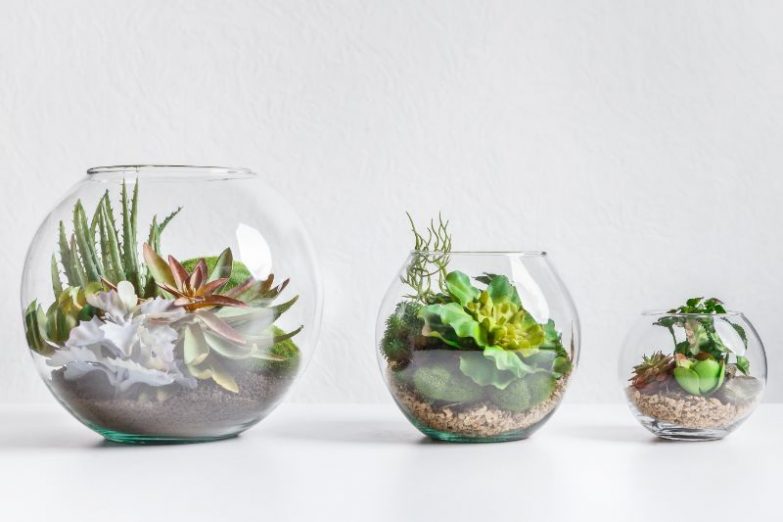Terrariums are trendy again: internet galleries are filled with eye-catching natural landscapes behind glass. Many terrariums are sealed, steamy junglescapes, but open terrariums are also popular and even easier to maintain. In this article, we’ll explain everything you need to know about open terrarium care, and help you fix, and avoid, common pitfalls.
Open Terrarium Care Summary: Open terrariums require careful watering and monitoring of the system’s moisture level. Routine maintenance includes pruning, debris removal, replanting, and keeping the glass and interior clean. Occasional fertilization and pest treatment are done as needed.
What Is An Open Terrarium?
The word “terrarium” may call to mind a closed container of moisture-loving plants, but uncovered terrariums are another great option.
Both versions feature artistic mini-landscapes of congenial plants. Open terrariums are for anyone who wants a natural green space but lacks the time for extensive upkeep.
Open terrariums are best for plants that don’t require humidity. The glassed-in space promotes bright, arid conditions, so a collection of succulents is the most common and practical plant choice.
Plants For An Open Terrarium
An open terrarium can house small, hardy houseplants, but it’s more advantageous as a setting for cacti and other succulents: they do exceptionally well in this small desert environment.
Not only are succulent collections unique, the plants grow slowly, are easy to maintain, and naturally look great together. Open terrariums are an excellent way to display the incredible assortment of shapes, sizes, spine patterns, and colors of these unusual plants.
No matter which type you decide upon, choose plants with similar preferences. It’s much easier to keep plants healthy when they thrive on the same requirements. Be aware of their dormancy cycles, too.
The watering requirement is the most important preference to match, but also consider your selection’s preferred light. If you want to grow succulents, note that not every specimen is a sun-worshipper that wants to bake in the heat. Choose plants that fit your terrarium’s conditions.
Sturdy succulents with fat leaves that store water are usually good candidates to handle the heat and droughts of terrarium life. As a general rule, darker plants usually tolerate less light than other succulents.
There are far too many suitable succulents to list, but here are a few popular, easy-to-keep candidates:
Open Terrarium Succulents For Direct Light
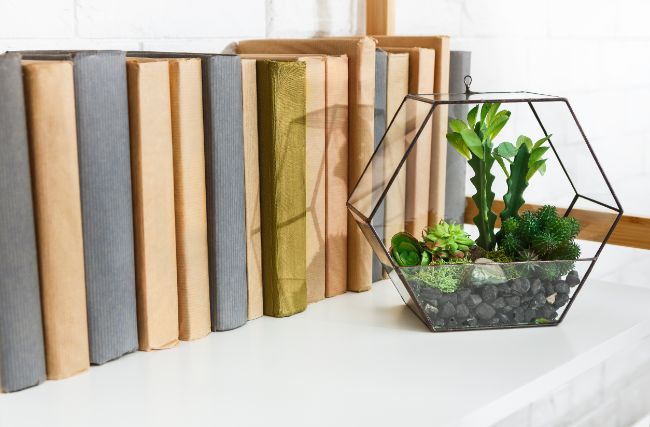
Echeveria – This low-growing Central American succulent has rosette-styled leaves shaped like a flower. They don’t mind tight spaces. There are countless variations including the popular “Neon Breakers” with purple leaves; variegated specimens exist, too. Echeverias produce flower on stalks late in the season. It’s sometimes called “Hen and Chicks,” but double-check before buying: the name can refer to other plants.
Sedum – This varied family is so hardy and forgiving of poor soil it’s commonly called “Stonecrop.” They typically grow fastest in full sun but can tolerate less. It’s a friendly beginner’s plant. One popular variety is the Burro’s Tail.
Tiger’s Jaw (Faucaria tigrina) – The descriptive name fits: a sharp row of spines grow on the edge of paired triangular leaves. It’s a low-growing succulent that won’t quickly outgrow its container. They love heat and, if given strong light, can bloom in the fall. There are many hybrids to choose from.
Agave – This highly varied succulent lends volume and texture to a scene. They are typically slow-growing, hardy, and love the sun. Though many Agaves are landscape plants, there are beautiful mini varieties that can live a long time in a terrarium before outgrowing it. One prized dwarf variety is the victoriae reginae.
Mammillaria – These cylindrical or ball-shaped succulents are miniatures of a classic spiny cactus. The family has many compact varieties perfect for an open terrarium—Powder Puff, Snowball, Pincushion, and Old Lady cacti are all easy to care for. They need lots of light and a sparse amount of water. They slow down over the winter and flower in the spring.
Kalanchoe – A free-flowering family of plants with a lot of variety, smaller specimens of this popular houseplant do well in an open terrarium. Most will outgrow the space eventually, but they don’t grow quickly indoors and will add months of upbeat interest and color to your miniscape. The Paddle Plant (Kalanchoe luciae) is a popular choice.
Aloe – There’s over 400 species of Aloe and an amazing number of hybrids, including tiny miniatures that thrive in open terrariums. They appreciate a lot of sun but not scorching rays. Suitable varieties include Guido, Crosby’s prolific, humilis, and the variegated Aloe descoingsii.
Lithops – These “living stones” are unique and stay small enough to be permanent terrarium residents. They resemble another interesting candidate in the same family, the Split Rock Plant (Pleiospilos). These fascinating succulents have the unfortunate reputation of being difficult, but that’s mainly because they need little water and rot easily. They do well with plenty of direct sun. Watering five times a year is generally enough; never water in winter.
Open Terrarium Succulents For Indirect Light
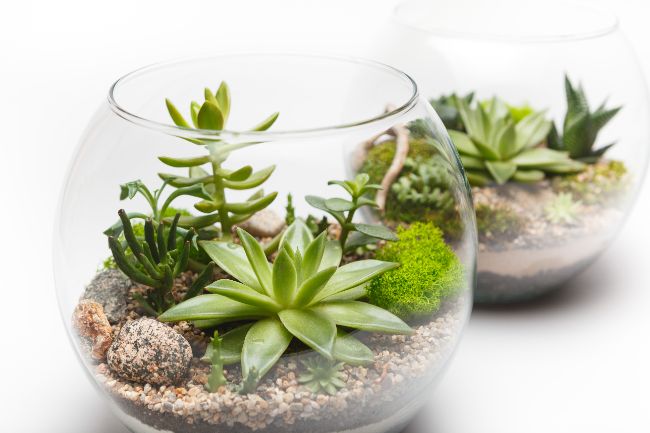
Haworthia – A large family of small, eccentric succulents. They need a bit more water than many succulents but won’t tolerate wet conditions and need careful watering. They don’t like direct sun, either, and are generally slow-growing. One top choice is the beloved Zebra (Haworthia fasciata).
Dwarf Sansevieria – This smaller cousin of the ever-popular and durable Snake Plant is easy to care for and tops out at six inches high. Its straplike variegated foliage make a nice contrast to blockier succulents. It accepts a range of bright indirect light but loses some striping in dim conditions. It grows rather slowly; water sparingly.
Rebutia – There are countless varieties of this popular button- or barrel-shaped family. They are easy to grow and flower easily, putting out summertime flowers that can be bigger than the plant itself. Rebutias like cool nighttime temps. They prefer strong light but will tolerate less.
Jade – Most jades will eventually outgrow a terrarium, but they grow slowly and respond well to being pruned. They make great bonsai plants for this reason. Jades prefer strong indirect light but can handle a wide range. The Hobbit Jade is unique and does well in terrariums.
Sand Rose (Anacampseros Rufescens) – These hardy succulents have fleshy leaves with green centers and pastel pink- or purple-tinged edges. They are slow growing and top out at four inches. They like infrequent watering and indirect light strong enough to bring out their colors.
Sempervivum – Another highly varied member of the Crassula family that includes Jade, Sedum, and Echeveria. It’s also called a “Hen and Chick” plant but, unlike Echeverias, Sempervivum dies after flowering. It grows in tight rosette-shaped clumps of fleshy leaves. The plant takes on different shades at different times of the year.
Ox-tongue Gasteria – This easy-going succulent comes in a range of sizes down to the dwarf glomerata or the liliputana which reach only 4 inches high. Their interesting strap-like leaves often have a rough texture. Gasteria like bright indirect light and can handle dimmer situations than many succulents. They are slow-growers that need little water.
Ball Cactus (Parodia) – The Parodia genus includes many easy-to-grow squat, small cacti that suit an open terrarium. Their spines are often unusual and showy. They don’t like intense sunlight and typically want a bit more water than other succulents. Two good varieties are Parodia haselbergii and leninghausii.
Maintaining An Open Terrarium
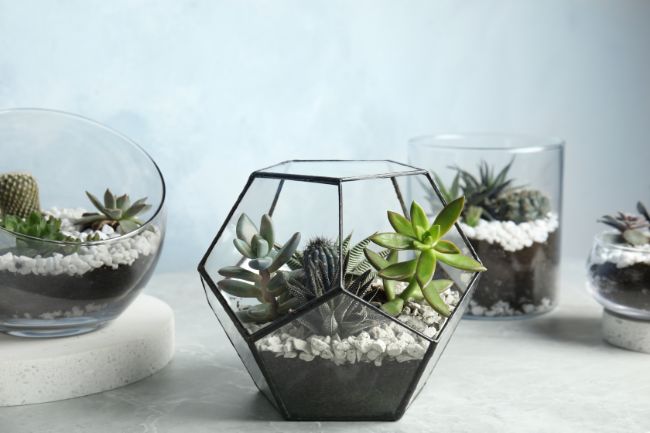
See The Light
Proper light is key to keeping succulents healthy. Even those that prefer only indirect light want a lot of it.
North-facing windows usually don’t provide enough sun: southern exposures that offer long bright hours are much better. East- and west-facing windows can suit lower-light succulents.
Even if you’re keeping succulents that tolerate direct sun, pay attention to the terrarium’s interior temperature. Mini-succulents are usually more tender than mature plants, and even heat-lovers can burn if their leaves are against hot glass.
Note how the sun’s position changes with the season; a suitable spot can become too bright or shady. Watch for legginess or loss of color that indicates inadequate light.
Give the terrarium a quarter-turn every two weeks so the plants don’t become lopsided.
Water Carefully
Watering succulents is easy in the sense it’s infrequent, but the timing requires careful observation. Too much moisture can cause deadly rot … but parched plants stop growing and shrivel up.
Another complication with many aesthetically pleasing terrarium containers is that there are no drainage holes. Unfortunately, a bottom layer of pebbles isn’t a substitute.
The popular method of thoroughly soaking dry soil only works if you have drainage. Without escape holes, the lower regions of the soil can stay wet – and nothing kills a tough succulent faster than soggy roots.
Here are tips to water correctly:
- Choose specimens that share watering requirements. Many succulents like the soil to go completely dry between waterings—but not all.
- Instead of watering on a schedule, check the soil.
- Moderation is critical for terrarium watering: think in teaspoons, not cups.
- Water the plant’s base and avoid getting its body wet. Many growers use an eyedropper or a spray bottle with a coarse stream instead of a watering can.
- Water less (or not at all) during the dormant season.
Groom As Needed
Pruning, transplanting, and debris removal are part of regular open terrarium care and maintenance, but the job is usually easy because most succulents aren’t fast growers.
Prune or relocate plants that touch the glass or interfere with another plant’s space or lighting. Overgrowth can sneak up on you: it helps to have an overall landscape plan to go by. Promptly remove dead leaves and other debris to prevent decay and eliminate hiding spaces for pests.
Plants grow at different rates, so don’t expect to prune everything at once. Regularly check the landscape so you can make adjustments early.
Replanting is another part of open terrarium care. Some succulents will languish or die off; offsets can overwhelm the scene. Don’t hesitate to liberate an overgrown plant or sprout to new quarters.
Fertilizing Plants In An Open Terrarium
Small terrarium succulents don’t need much in the way of fertilizer. Keep in mind that you don’t want to encourage rapid growth.
The only time your terrarium plants need extra nutrition is when they’ve been in the same soil for many months or the medium is infertile. Some growers suggest a light feeding once or twice a year, but use your judgment.
When you do feed, dilute the fertilizer to 1/4th strength and apply with a normal watering. Organic fertilizers are gentle and can boost soil health, but they can also attract insects. Read more about fertilizing indoor plants in this article.
Cleaning An Open Terrarium
Regularly dust the leaves with a paper towel or tissue. Remove debris-covered stones and other hardscape to rinse them off. Let them air dry before replacing.
Keep the glass clean so the light shines through without obstruction. Commercial chemicals are fine for the outside, but wipe the interior with distilled water. Wrap a chopstick or other tool with a paper towel to clean in tight crevices and beneath foliage.
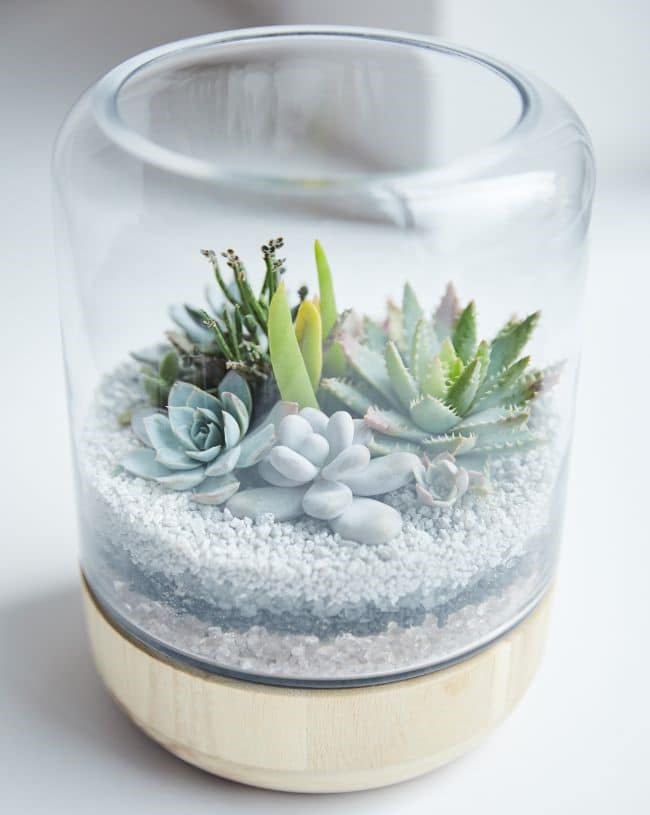
Open Terrarium Care Problems And Prevention
A properly constructed and maintained terrarium is typically trouble-free, but issues can always crop up. Here are common problems with open terrarium care:
Yellowing Plants
Overwatering is the main culprit in succulent problems. Even indestructible species are surprisingly vulnerable to too much moisture. Their natural habitat is dry, so they don’t have much protection against decay pathogens that thrive in soggy soil.
If you see yellowing areas on a plant, carefully check the soil. Stick your finger or a wooden chopstick all the way to the terrarium bottom. If the soil is moist, let it thoroughly dry out before watering again. Increasing air circulation will speed evaporation.
Check for puffy foliage and stems, and remove plants that show signs of rot. The disease spreads quickly. If you want to try saving a specimen, do it outside the terrarium.
Remove dying or decomposing vegetation, and don’t rewater until all areas of decay have dried.
If you’ve haven’t overwatered, consider these possibilities:
Humidity – This isn’t usually a problem with open terrarium care because the air in most homes is quite dry, but humidity could be an issue in a highly tropical area or if you have a humidifier – or a big group of plants. If so, make sure the container has good light and keep watering to a minimum.
Lack of Nutrition – Even though tiny succulents aren’t heavy feeders, poor or exhausted soil can cause stunting or yellowing. Check other possibilities first and consider using a soil test kit to make a diagnosis. If you decide to fertilize, dilute to 1/4th strength.
Crispy, Dry Plant Parts
It is possible to underwater a succulent. Typically you’ll see warning signs of shriveling, but a long dry spell can definitely cause yellowed or browned foliage and stems. Symptoms can superficially resemble overwatering, so check the soil – it will need to be quite dry to conclude that underwatering is the problem.
Overheating is another cause of desiccation. Clear glass of a terrarium allows sunlight to penetrate but this also generates heat: that’s why a sunny window is so warm. This temperature increase can scorch your plants. Check the conditions during the heat of the day.
Diseases And Pests
Most succulent diseases are caused by soggy conditions. Root rot is the most common and deadly. Letting the soil dry properly between waterings is the best preventative and one of the most important factors in good open terrarium care. Some growers mix cinnamon in the soil as a light natural fungicide.
Succulents can be susceptible to spider mites: the little arachnids like things hot and dry. Signs are tiny webs and discolored spots on leaves. An infestation can cause the entire leaf to yellow and die.
Mealybugs are also common. They appear as cottony patches under leaves or in leaf joints; they cause stunting or malformed new foliage. They spread quickly.
One easy treatment is to spray or dab the pests with 70% Isopropyl alcohol. Remove the terrarium from intense light for a day or so after treatment to avoid burns. This also works for scale and whitefly.
Insecticidal soap is another effective, mild treatment. Make sure to coat the undersides of leaves. One application won’t do it: reapply until they’re gone.
Planting Tips
- When adding plants to your terrarium, choose a mix of large and small specimens for a naturally interesting scene.
- Select healthy, firm, chubby succulents without nicks or blemishes. Avoid leggy plants.
- Quarantine new specimens for a few weeks before adding them to a setup. It’s harder to treat pest and diseases once they’re part of a terrarium’s ecosystem.
- Rinse your plants thoroughly before planting. This step reduces the chance of hitchhiking pests.
- Use sterile soil to avoid bringing pests and mold spores into your botanical creation. Consider baking the soil to be sure.
- Don’t place everything tightly in its final design. Give the plants room to grow.
- Filtered or distilled water is recommended if your terrarium lacks drainage. Salts and residual chemicals remain in the soil after the water evaporates, where they can build up and toxify the roots over time.
- Sterilize your tools before pruning, and make sure the blade is sharp. Bruised foliage or stems invite decay.
- Try to catch problems early, and treat pests at first sighting. It’s best to remove plants under attack.

